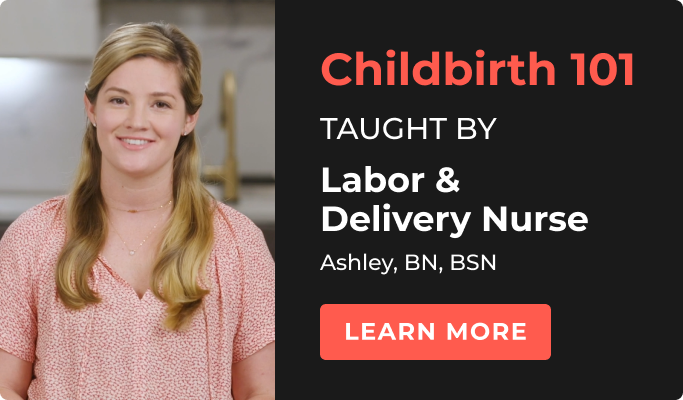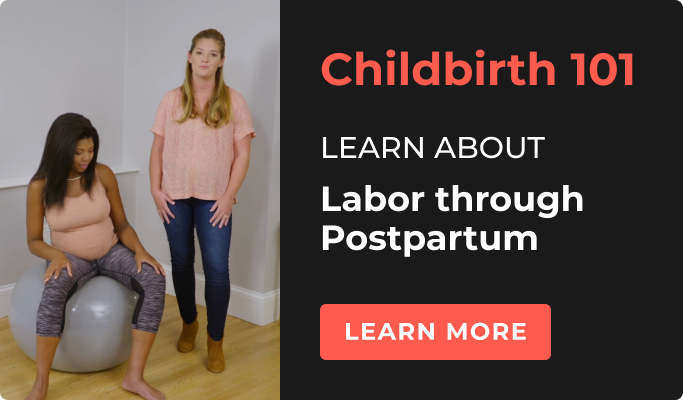When you’re pregnant, it’s natural to feel anxious about childbirth. Most of that fear comes from wondering how painful childbirth will actually be. Successful pain management starts with minimizing fear, and the best way to minimize fear is with education. That’s one reason why taking a childbirth class during your pregnancy is important.
During your class, you will learn many ways to prepare for labor, including all your options for pain management. And, since babies are, well, babies, they don’t always stick to the plan so it’s important to know all your options no matter what type of birth you plan on having — a medicated or unmedicated birth — there are pros and cons to both. If you do plan on having an unmedicated birth, however, follow these expert tips to get you through successfully.
7 Tips for an Unmedicated Birth:
1. Take a childbirth class. One great way to prepare for labor and delivery is by taking one of the many types of childbirth courses available to you. In most birthing classes you will learn about labor, birth, and the postpartum period — helping you feel more confident and prepared.
In our online course, Childbirth 101, you’ll not only learn what to expect from your body, your baby, and your providers, but our expert will walk you through how to effectively manage pain (no matter how you plan to or end up delivering!), birthing positions, stages of labor, packing your hospital bag and so much more.
2. Know what to expect from your body. Your body will go through a lot of changes not only during pregnancy but also during labor and delivery., Learning what exactly is happening with your body as it progresses through labor and finally delivery will help you visualize and get through the pain as it comes.
3. Learn relaxation techniques. Try practicing some of these things before you’re in labor, with your support person. The less tension in your body, the better.
Create a soothing environment using aromatherapy, music, and lights
Visualization or guided imagery
Massage (include your partner in this!)
Effleurage
Hip squeezes/counterpressure
Knee press
Acupressure
Progressive relaxation
Water therapy
4. Use breathing techniques. Breathing during labor helps calm the body, relieve pain, lower stress, and can give you a sense of control. There are 3 techniques our expert recommends laboring parents use:
Slow-paced breathing
Moderate paced breathing
Patterned breathing
One thing to note is that if you ever feel short of breath or lightheaded during a breathing exercise, stop and resume your normal breathing pattern.
5. Establish your birth preferences. There are many options you’ll face during childbirth. Prior to going into labor, you should decide what your birth preferences are. This includes: your medication preferences, postpartum preferences, preferred feeding method, birthing environment, and more. Our customizable Birth Preferences handout will help you talk through your options. Download here.
6. Pack your hospital bag. When having an unmedicated birth, there are some items from home that might be helpful for you. From specific clothing to a favorite blanket to help calm you, and more, make sure you talk with your providers to see what will be provided for you and what you’ll want to bring.
7. Prepare your support person(s). Have your support partner or partners join you during your childbirth class (a great reason to take an online course!), and talk through the options you have, the decisions you’ve made and how they can help with pain management along the way.
One other item you might want to consider: set yourself up for postpartum before you have your baby. This way, when you return from the hospital, you’ll have all the items you need, conveniently around your house, ready to help you heal.
For more expert tips and in depth explanations of each way to manage pain and prepare for a medicated or unmedicated birth, check out our online course Childbirth 101: From Labor through Postpartum. Taught by experienced Labor and Delivery Nurse and Childbirth Educator, Ashley Derderian Sousa, you’ll learn everything you need to know —and what other parents wish they had known — about labor and childbirth. Including what to expect during the final weeks of pregnancy (including how find relief from common aches and pains), how to know you are in labor and when to head to the hospital, a deep dive on the phases of labor, all the ways labor can go, what to expect in the first few hours and days after birth, and what to expect postpartum.




